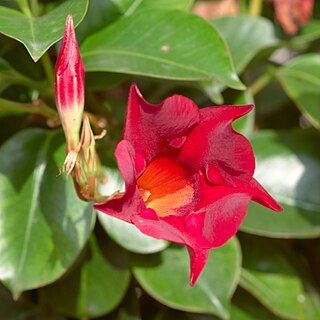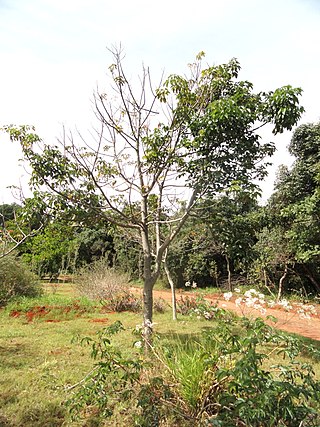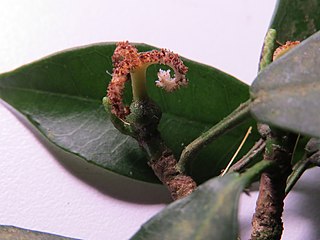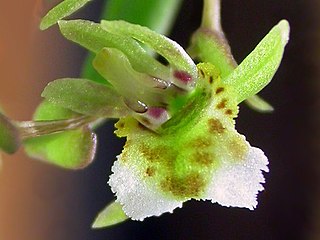
The Canellaceae are a family of flowering plants in the order Canellales. The order includes only one other family, the Winteraceae. Canellaceae is native to the Afrotropical and Neotropical realms. They are small to medium trees, rarely shrubs, evergreen and aromatic. The flowers and fruit are often red.

Carl Friedrich Philipp von Martius was a German botanist and explorer. Between 1817 and 1820, he travelled 10,000 km through Brazil while collecting botanical specimens. His most important work was a comprehensive flora of Brazil, Flora Brasiliensis, which he initiated in 1840 and was completed posthumously in 1906.

François-Louis Nompar de Caumont Laporte, comte de Castelnau was a French naturalist, also known as François Laporte or Francis de Castelnau. The standard author abbreviation Castelnau is used to indicate him when citing a botanical name and zoological names other than insects. Laporte is typically used when citing an insect name, or Laporte de Castelnau.

Mandevilla is a genus of tropical and subtropical flowering vines belonging to the family Apocynaceae. It was first described as a genus in 1840. A common name is rocktrumpet.

Caryodendron is a plant genus of the family Euphorbiaceae first described as a genus in 1860. The genus includes C. orinocense, known as the Inchi tree or Tacay nut. It is native to Central America and South America. They are dioecious trees.
- Caryodendron amazonicumDucke - Amazonas in Brazil
- Caryodendron angustifoliumStandl. - Costa Rica, Panama, Colombia
- Caryodendron janeirenseMüll.Arg. - Rio de Janeiro
- Caryodendron orinocenseH.Karst - Colombia, Venezuela, Ecuador
Romanoa tamnoides is a species of plant of the family Euphorbiaceae. It is the sole species in the monotypic genus Romanoa, first described in 1824. It is native to Brazil and Paraguay.

Joannesia is a genus of plants in the family Euphorbiaceae, first described as a genus in 1798. The entire genus is endemic to Brazil.

Algernonia is a plant genus of the family Euphorbiaceae first described as a genus in 1858. It is native to Peru and Brazil.

Vriesea is a genus of flowering plants in the botanical family Bromeliaceae, subfamily Tillandsioideae. The genus name is for Willem Hendrik de Vriese, Dutch botanist, physician (1806–1862). Its species are widespread over Mexico, Central America, South America and the West Indies.

Campomanesia is a genus in the family Myrtaceae described as a genus in 1794. It is native to South America and Trinidad.
José Mariano de Conceição Vellozo (1742–1811) was a Colonial Brazilian botanist who catalogued specimens, for example: Cedrela fissilis Vell. in Florae Fluminensis. He was born in Tiradentes, formerly called São José do Rio das Mortes, state of Minas Gerais; and died in Rio de Janeiro, state of Rio de Janeiro. While at the University of Coimbra in Portugal in the 1790s he worked with Martim Francisco Ribeiro de Andrada in translating works on mineralogy and agriculture. The standard author abbreviation Vell. is used to indicate this person as the author when citing a botanical name.
João Geraldo Kuhlmann was a Brazilian botanist.
Mangonia is a genus of flowering plants in the family Araceae. The genus contains only two known species native to southern Brazil and Uruguay.
- Mangonia tweedieanaSchott. - Rio Grande do Sul, Uruguay
- Mangonia uruguaya(Hicken) Bogner - Cerro Largo in Uruguay

Isabelia is an orchid genus formed by three tiny species and one natural hybrid, spread from the Northeast of Brazil to Argentina, which are closely related to the genus Constantia. During more than a century Isabelia was a genus formed by just one species, however, around 1968, it was merged with genus Neolauchea, also unispecific. In 2001, a third genus was added to it, Sophronitella. The genus name is abbreviated Isa. in cultivation.
Austrocritonia is a genus of flowering plants in the family Asteraceae.

Bixa is a genus of plants in the family Bixaceae. It is native to Mexico, Central America, Caribbean, and South America, and naturalized in other places.

Prescottia is a genus of flowering plants from the orchid family, Orchidaceae. It is widespread across much of Latin America and the West Indies, with one species (P. oligantha) extending into Florida.

Rauhiella is a genus of flowering plants from the orchid family, Orchidaceae.

Saranthe is a genus of plants native to Brazil and Paraguay, described as a genus in 1861.
Cinnamodendron axillare is a species of flowering plant in the family Canellaceae. It is found in the state of Rio de Janeiro in Brazil.













